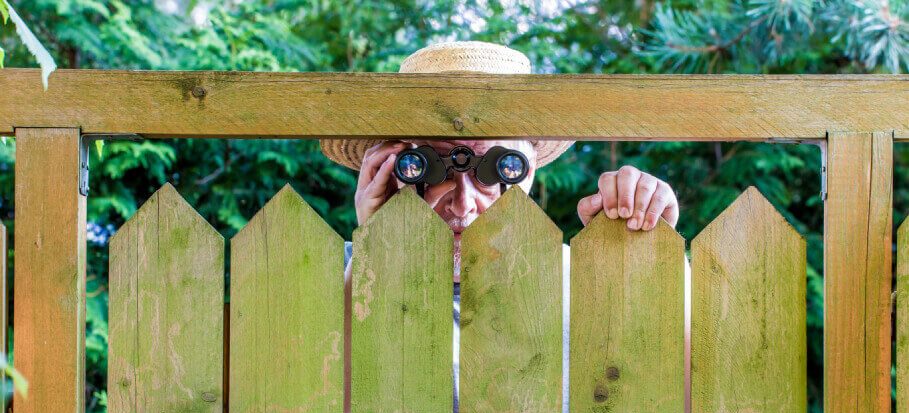
Everyone wants to have a place of peace and silence where they can be alone with their thoughts or even not think at all. And what better spot than a calm, beautiful garden.
However, nowadays, achieving much-needed solitude is becoming harder and harder, especially if you’re surrounded by nosy and curious neighbours. In this article, you will read about all the best garden privacy screen ideas that will help you to create your very own garden heaven, away from prying eyes and unwanted noise.
Table of Contents
Why do you need privacy in a garden overlooked by neighbours
Evaluate your area to decide on the necessary type of garden screening. This can cover one or more of the following:
- Set aside a garden next door. Hide an unattractive sight.
- Restrict the second-story window of a neighbour from seeing down into your backyard.
- Plan a buffer from a neighbouring public area, such as a busy path or pavement.
- Establish privacy between garden features, including a hot tub, patio, or deck.
- Safeguard from potential attackers.
- Provide pets and child’s secure place for play.
Factors to consider
- Select privacy barriers whose scale fits the available area.
- Make sure flora and hardscape elements enhance your house’s architectural design.
- Look for screening ideas within your budget. Choose plants and materials durable over time, since they will save money.
- Will a privacy solution cause your own yard or neighbours too much shadow? Will it create shadows over a vegetable garden needing complete sun or a swimming pool?
- Consult the local building regulations, which have their own standards for property boundary setbacks, outbuilding size, and fence height.
- Too many privacy barriers, or too big barriers might make a garden seem enclosed. Combining several privacy screens could help a space seem more roomy.
- Too many privacy barriers, or too big barriers might make a garden seem enclosed. Combining several privacy screens could help a space seem more roomy.
- For more complex tasks, consult an architect or landscape designer.
Reinforce your privacy with fence repair or install a new one
A good start to building your small garden fortress is to make sure there is a strong, thick fence between you and the rest of the world. Unfortunately, this barrier is usually the first one to go during storms and strong winds.
So, if you have a fence that has been damaged at some point, consider either fixing the existing remains or installing a brand-new fence. Whether you do all on your own or decide to call a professional to repair your fence is entirely up to you. It mostly depends on how damaged your fence actually is.
For example, if you have a wooden one that only has some broken or bent panels, you can easily replace them with new ones. If the whole fence has fallen down but it’s still undamaged, check for any loose or wrecked nails, hammer some new ones and put it back up. In case you need to purchase some replacement panels, always look for treated wood, as it will last longer than cheaper, untreated options.
If you don’t have a barrier, or it’s just not tall enough, reinforce your privacy with fence installation. We advise you to call a professional to make sure that everything is placed properly so you won’t have any problems in the future.
Bamboo or Willow Fencing is also a good privacy decision
Another stylish and sturdy option is to have a Bamboo fence. It’s proven to be a lot stronger than a wooden one, standing up even to the strongest winds. So you can block the glimpse of your neighbour’s backyard with bamboo fences.
That will also give a nice exotic look to your garden by elegantly blending with the rest of the green life there. You can also use willow fences as alternative privacy providers, especially if you need something that will serve as a windbreak.
Trellis ideas for privacy
Even if they are not as popular as normal fences or the bamboo ones, trellis panels are an achievable landscaping idea if you need to gain some extra privacy for your backyard oasis. You can choose from a wooden or a metal panel fence, depending on the overall design of your garden. It’s fairly easy to construct, and you can check out different DIY ways of building this fence, or you can hire a professional to do it for you.
Once you have the trellis installed, you can add some vine plants. They can have a decorative purpose or even a defensive one if you decide to go with a type of vine that has thorns. This way, you can be sure that no one will come even close to your property, never mind peeking in or trying to trespass.
Improve your privacy by adding a trellis on top of your fence!
Enter your postcode to view our rates and availability in your area.
For questions about the services we offer visit our main site
What is the maximum allowed trellis fence height?
Each area usually has different restrictions regarding the maximum height of a fence. Check with your local council what those regulations are. The usually permitted height is around 2 metres.
However, in cities like London, for example, the majority of people really do cherish their privacy and it’s not uncommon to see fences higher than that. You will only need a planning permission to do so. If you are allowed, consult with your neighbours to see if this height will be suitable for their garden needs, as well.
What plants can you grow on a trellis?
If you decide to go with a trellis fence and you need your privacy, you will probably have to invest in some trellis-appropriate climbing plants. Since this type of fence is not solid, without any plants, it will not serve as a good barrier between you and your neighbours.
Luckily, there are plenty of varieties you can choose from, and we’ve compiled the best ones below:
- Climbing Roses. Roses are for sure one of the most popular choices for people with a trellis fence. There are a lot of subspecies that you can plant, but if you want fast results, we recommend that you go with the Ramblin’ Red rose. It’s resistant to harsh weather conditions and a number of diseases. In only a single season it will reach a height of more than 2 metres.
- Jasmines. This is another fast grower that is perfect for a trellis. You will need to plant it around 10cm away from the bottom of the fence and in rich, organic soil. Make sure that there is enough sun in the area you’re planting the jasmine. When it starts growing you will only have to weave the vines through the trellis holes. As soon as it reaches the top of the fence, start cutting it so it will start to spread on the sides.
- Honeysuckle. Growing honeysuckle is not a hard task. It’s a vine shrub that will easily latch on to your fence and it also has an amazing sweet fragrance that will add to the cosy atmosphere of your garden.
- Clematis. Also known as Traveller’s joy, this genus has the ability not only to climb up on different structures but to grow through various plants, as well. It’s not a pretentious flower and it can be grown almost at any time of the year.
- Morning Glory. The name of this beautiful flower species comes from the fact that they fully bloom as soon as the sun rises. Most Morning Glory’s can be raised in almost any soil and type of sun exposure. However, check the requirements for the specific flower you have decided to have and see if it needs something different.
- Blue Moon Wisteria. This Wisteria is perfect for a trellis fence as it blooms three times a year! It’s also very resistant to low temperatures. It grows really high so make sure to cut it once it gets to the top of the fence.
Garden privacy screening with pergola feature
However, if you still want more isolation and the fence and trellis are not satisfying your needs, opt for privacy pergola. Pergolas help to set up a small area in the garden tailored just for you, especially laced in flowers and vines. This elegant construction gives you not only a great place to relax but also provides an aesthetic look to the garden.
Is planning permission required for a pergola?
In the UK, pergola building regulations do not require planning permission as long as their height doesn’t exceed 2.5 meters. The good news is that they can be built up to 4 meters if there is a 2-metre distance between the pergola and the fence itself.
Keep in mind, though, that in this case, the eaves must not exceed 2.5 meters in height. Check your local council for pergola height restrictions in England.
Plant hedges and shrubbery to maintain your privacy in the garden
If you want your garden to look as natural as possible, use hedges instead of wooden or metal fences to achieve the desired effect. They will combine visually with the rest of the green life in your garden and will also be perfect for filling any gaps between fences or walls. Shrubs and hedges come in all different shapes and sizes, so you’ll certainly have a lot to choose from.
Here are some of the best varieties that would fit perfectly in most gardens:
Blue Hydrangea
This is a subspecies of the Hydrangea family that produces blue flowers which is a bit less common than the other colours you can get from it. The blooming season is in Autumn and Summer, while the rest of the year, you can enjoy the thick, beautiful green foliage.
North Privet
The Privet hedges are possibly the best kind that you can have if you need to keep noise away from your private space. They have solid, green foliage that grows fast and will quickly provide you with a windproof, natural fence you will enjoy for years to come.
Beautybush
This shrub easily spreads on its own and will provide you with a splendid dark-green foliage barrier. Late spring and early summer are the times when the tender pink bell-shaped flowers of the Linnaea Amabilis will start blooming.
Pee Gee Hydrangea
These tall and impressive shrubs are perfect for people living in areas with a harsh, cold climates. It’s also a fast grower that produces beautiful, grand white flowers in its blooming season. Pee Gee Hydrangea is also one of the few shrub species that can be pruned into the shape of a tree.
Juniper Shrubs
The Juniperus is another popular choice amongst homeowners because of its clear-cut structure, making it the perfect substitute for a normal fence. These shrubs are also resistant to various types of weather and do not require much maintenance in order to keep their strong shape.
Camellia
In order to grow Camellias in your garden, there is only one condition – no chalk. If you live in an area in the UK without chalk, you shouldn’t have any problems whatsoever with this acid-loving plant. It tolerates different kinds of shade, so it can be grown in many parts of your garden. Some types of Camellia shrubs have the ability to produce different coloured flowers in different parts of the plant.
However, the most common colour is the white one. When growing Camellia, there is one thing you should be careful about in the first years of establishing the shrub. You have to protect it from strong winds so it doesn’t break before it grows completely.
If you go for the hedge option, make sure to trim and prune your “live fence” according to the species of hedge it’s made out of.
Plant evergreen trees
Evergreen trees might take a lot of time to grow to the size you will need them to be, but once they do, the plant will serve as a protector of your garden for the whole year round.
- Cedar Trees
The overall look of the Cedar Tree is one that easily blends with almost every possible garden design. Because of its size and density, it serves as a windbreaker, however, it’s not recommended to plant it if your backyard is not really spacious.
- Italian Cypress
This easygoing Cypress is not the type of tree that can cause any trouble or requires a specific maintenance routine. The only thing you should look out for are spider mites, but otherwise, it’s just a fast grower that will give your garden an everlasting green splash of colour.
- Laurel Trees
Laurel trees are perfect for every garden size as they can be pruned depending on your wishes. You can let the plant grow as high as you need it to be. Different kinds of the Laurel trees have different leaf size, so choose the one that will suit the rest of the garden. There are variations of the colour as well, so you can choose from bright green, dark green or one with multicoloured leaves.
- Leylandii Trees
These trees are most popular around the UK as they are the type that grows the fastest. The high density of the foliage will protect your garden from the strong winds. The shape and size of the Leylandii Tree depend entirely on how you trim it, meaning that you can easily customize it to suit every type of garden.
Create low seating area
Choosing low seating not only is practical but also provides privacy from above if you are in an enclosed outdoor, say a backyard patio. This will help you feel more at ease from passersby. One cheap approach to achieve this is to toss outside throw cushions.
Add curtains
Curtains will completely change your outdoor area, whether your goal is more privacy from your house or just protection from the strong afternoon light. Once you have the ideal outside curtains, though, you will have to choose how best to hang them.
You can hang curtains on your patio, balcony or just where you have established a seating area. Every outdoor area is unique, so no one-size-fits-all solution.
Install a living wall
Mount plant pots to a piece of wall or screen you choose. Certain wall-hanging designs will include hooks or cable ties instead.
Arrange a variety of plants. They could be seasonal, completely foliage-based or floral. Trailing variety will cover the area effectively and give herbs some thought as well. For a flash of colour, plant tall varieties next to it. For example, hollyhocks, snapdragons or foxgloves will provide height.
In conclusion
As you can see, there are many ways to keep your privacy even if you are surrounded by people. Whether you choose to go with an actual fence, a trellis, or just use nature’s power to keep unwanted presence away, all you need is a bit of imagination and desire.
We hope that you found our article interesting and, most importantly – useful. Let us know what you think in the comments below and don’t forget to share it with your family and friends. Happy gardening!
We can install a fence and help improve your home’s privacy with more solutions!
Enter your postcode to view our rates and availability in your area.
For questions about the services we offer visit our main site
Image credit: Rainer Fuhrmann | Shutterstock.com




Haha, sometimes bushy plants in boarder of the garden can keep privacy of garden. There is no need to set up extra security.
Thank you for sharing your opinion with us, Rakibul! We should also aim at aesthetics, so we can’t let our readers’ and customers’ hedges overgrow.
This is an excellent guide. Great Job!
These are brilliant ideas! I’m a landscaper in the US and I’ve done several privacy projects. I like them so much that I’m thinking of adding one to my own backyard. Thanks for sharing your experience and insights!
Thanks for all the great ideas on making yards more private, particularly the section on evergreen trees (naturally). Wonderful article with loads of great information. Thanks again.
Great and useful ideas. Everyone needs a little privacy in the yard. Thanks for the article!
Good ideas to make trellises come to life with a nice selection of plant options. Thanks.
This is an awesome article stating the landscaping ideas for privacy in the garden in detail. They are a must-read for many. This article is a good one to look at. I like how you have researched and presented these exact points so clearly.
Thanks for such an informative post. You have mentioned the amazing facts. Your articles are always amazing. Keep posting!
This gave me so many great ideas for my yard. We recently rented a dumpster and got rid of our old fence and a bunch of dead trees. It was a long time coming. But now that is all cleaned out we feel like our neighbors can look straight into our yard. We love our neighbors but got used to the privacy we had with the trees and fence. You gave me many ideas to think about. Thank you!